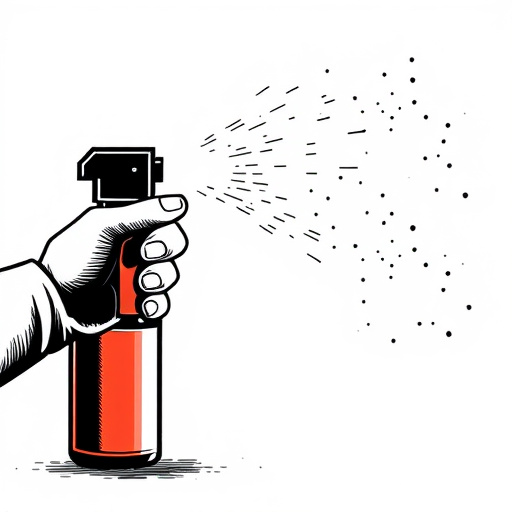Civilian pepper spray requires immediate decontamination after use. Steps include removing contaminated clothing outdoors, rinsing eyes and skin with water for 15 minutes, using a baking soda solution, and ventilating/disinfecting high-touch home surfaces. Kit preparation and educating household members enhance emergency readiness.
“In today’s world, personal safety is paramount. Civilian-grade pepper defense spray has emerged as a powerful tool for individuals seeking protection against potential threats. This article guides you through essential aspects of this non-lethal self-defense mechanism. We’ll explore the key features and benefits of civilian pepper spray, offer practical decontamination steps to manage exposure risks at home, and provide tips to enhance your safety measures. By understanding these simple yet effective Pepper Spray Decontamination Steps at Home, you can take proactive control of your well-being.”
- Understanding Civilian Pepper Spray: Key Features and Benefits
- Step-by-Step Guide to Effective Pepper Spray Decontamination
- Home Safety: Preventing and Managing Pepper Spray Exposure Risks
Understanding Civilian Pepper Spray: Key Features and Benefits
Civilian-grade pepper defense spray is a powerful personal safety tool designed for everyday carry and home protection. Unlike its military counterparts, which are highly specialized and often restricted, civilian pepper spray offers a more accessible option with a range of features tailored to meet the needs of individuals and families.
Key features include a wide range of strengths, from mild to extra-strong, ensuring users can choose the appropriate level of force for different situations. Benefits extend beyond deterrence; pepper spray decontamination steps at home are relatively simple. Users should always follow manufacturer instructions, but general practices involve quickly rinsing eyes and skin with water, removing contaminated clothing, and ventilating the area. This makes civilian-grade pepper spray not just a deterrent but also a practical addition to personal safety strategies.
Step-by-Step Guide to Effective Pepper Spray Decontamination
After a civilian-grade pepper spray incident, proper decontamination is crucial for both safety and legal reasons. Here’s a step-by-step guide tailored for Pepper Spray Decontamination Steps at Home.
1. Remove Contaminated Clothing: Immediately doff any clothing or items that may have come into contact with the spray. Hang them outside in a well-ventilated area to air out, minimizing the risk of spreading the irritant indoors. Never wash contaminated clothes inside your home to avoid cross-contamination.
2. Rinse Eyes and Skin: If pepper spray has made contact with your skin or eyes, head outdoors (preferably an area with high ventilation). Rinse thoroughly with clean water for at least 15 minutes. This helps dilute the capsaicin oil responsible for the burning sensation. For eye irritation, continue flushing until any stinging or tearing subsides.
3. Use Baking Soda and Water Solution: For affected areas on your skin not reachable with water alone, apply a paste of baking soda and water. Let it sit for several minutes before gently scrubbing off the residue with a wet cloth. This can help reduce skin irritation caused by the spray.
4. Ventilate and Disinfect High-Touch Surfaces: After decontaminating yourself, focus on cleaning high-touch surfaces within your home that could have been contaminated. Use a solution of one part bleach to ten parts water, or a commercial cleaner effective against viruses and bacteria. Wipe down doorknobs, light switches, and other frequently touched items to prevent the spread of any potential irritant or virus.
Home Safety: Preventing and Managing Pepper Spray Exposure Risks
In the interest of home safety, understanding pepper spray decontamination steps is paramount, especially considering its increasing availability as a civilian defense option. If exposed to pepper spray, whether during an unexpected break-in or accidental discharge, prompt and effective decontamination is crucial for mitigating health risks. Start by moving to an area with fresh air; open windows or doors to ensure ventilation. Remove any contaminated clothing immediately, placing them in a sealed plastic bag for later disposal. Rinse affected eyes thoroughly with clean water for at least 15 minutes, ensuring the spray doesn’t reach your face. For skin exposure, wash the affected areas with soap and warm water.
To enhance pepper spray decontamination steps at home, create a kit with essential supplies: eye irrigation solution, disposable gloves, protective eyewear, and a sealed bag for contaminated items. Educate all household members on emergency procedures and locate the kit in a readily accessible place. Regularly review and practice these decontamination steps to ensure everyone is prepared for potential situations, contributing to a safer home environment.
Civilian-grade pepper defense spray is a powerful tool for personal safety, but proper handling and decontamination are crucial. By understanding the key features and benefits, following effective decontamination steps, and implementing home safety measures, you can minimize exposure risks. Remember, knowledge and preparation are essential in ensuring your safety and peace of mind. Implement these pepper spray decontamination steps at home to stay protected.
